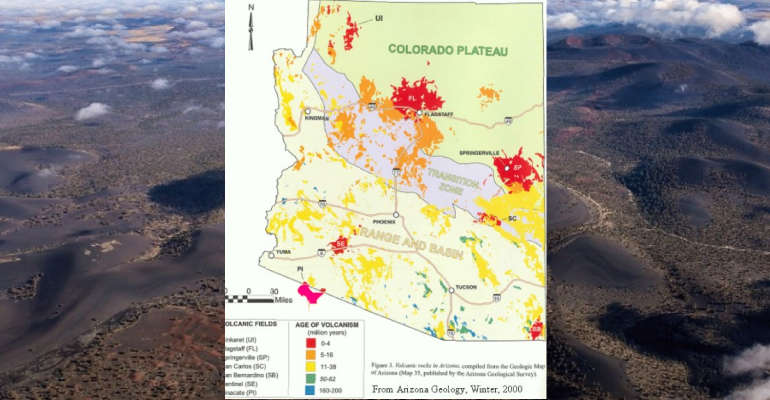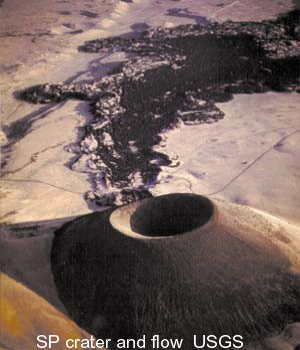
The volcanic history of Arizona spans more than one billion years. Last Sunday I wrote about Arizona’s youngest volcano, Sunset Crater. Today, I look at other young volcanic fields in Arizona.
There are seven volcanic fields which have erupted within the last four million years. One of them entombs pottery of local inhabitants of the time. One dammed the Colorado River in the Grand Canyon several times. Another produces world-class gemstones, and another is associated with the 1887 earthquake which shook Southern Arizona and Northern Sonora.
The map below, from the Arizona Geological Survey shows the location of these recent and older volcanic fields. This article discusses those shown in red.
The Uinkaret Volcanic Field (UI on the map)
The Uinkaret volcanic field lies on the north rim of the Grand Canyon in northwestern Arizona. Four major eruptions of basalt from this field flowed into the Grand Canyon and dammed the Colorado River between 725,000 and 475,000 years ago, between 400,000 and 275,000 years ago, between 225,000 and 150,000 years ago, and between150,000 and 75,000 years ago. (Source).
Dating was done by radiometric methods using the ratio Argon-40 to Argon-39.
Some of the eruptions flowed down the canyon as much as 75 miles. Some of the dams reached more than 700 feet high. When the river eventually over-topped and broke the dams there were great floods. There is no consensus on how long the dams lasted. Some think they may have lasted up to 20,000 years and formed large reservoirs.
According to the Smithsonian Institution, “One lava flow, from Little Springs, south of Pliocene Mount Trumbull, has a cosmogenic helium age of 1300 +/- 500 years BP. Pottery sherds dated at between 1050 and 1200 AD were found within the Little Springs lava flow, which occurred about the same time as the Sunset Crater eruption in the San Francisco volcanic field to the SE.”
San Francisco Volcanic Field (FL near Flagstaff)
The San Francisco volcanic field near Flagstaff has been active for about 6 million years. The oldest eruptions occurred near the town of Williams. Sunset Crater, a cinder cone east of Flagstaff, is less than 1,000 years old.
The US Geological Survey says, “It is likely that eruptions will occur again in the San Francisco Volcanic Field. With an average interval of several thousand years between past periods of volcanic activity, it is impossible to forecast when the next eruption will occur. U.S. Geological Survey (USGS) scientists believe that the most probable sites of future eruptions are in the eastern part of the field and that the eruptions are likely to be small. These future eruptions may provide spectacular volcanic displays but should pose little hazard because of their small size and the relative remoteness of the area.”
Humphreys Peak, Arizona’s highest mountain at 12,633 feet, is a stratovolcano which erupted between 1 million and 400,000 years ago. This volcanic mountain consists of interspersed layers of andesitic lava, cinders, ash, and volcanic mudflows.
 The younger volcanic cones and their flows are basaltic, such as SP crater (71,000 years old) and Sunset Crater. According to the USGS, “Most of the more than 600 volcanoes in the San Francisco Volcanic Field are basalt cinder cones. Basalt has the lowest viscosity of all common magmas. Cinder cones are relatively small, usually less than 1,000 feet tall, and form within months to years. They are built when gas-charged frothy blobs of basalt magma are erupted as an upward spray, or lava fountain. During flight, these lava blobs cool and fall back to the ground as dark volcanic rock containing cavities created by trapped gas bubbles. If small, these fragments of rock are called “cinders” and, if larger, “bombs.” As the fragments accumulate, they build a cone-shaped hill. Once sufficient gas pressure has been released from the supply of magma, lava oozes quietly out to form a lava flow. This lava typically squeezes out from the base of the cone and tends to flow away for a substantial distance because of its low viscosity. SP Crater, 25 miles north of Flagstaff, is an excellent example of a cinder cone and its associated lava flow.”
The younger volcanic cones and their flows are basaltic, such as SP crater (71,000 years old) and Sunset Crater. According to the USGS, “Most of the more than 600 volcanoes in the San Francisco Volcanic Field are basalt cinder cones. Basalt has the lowest viscosity of all common magmas. Cinder cones are relatively small, usually less than 1,000 feet tall, and form within months to years. They are built when gas-charged frothy blobs of basalt magma are erupted as an upward spray, or lava fountain. During flight, these lava blobs cool and fall back to the ground as dark volcanic rock containing cavities created by trapped gas bubbles. If small, these fragments of rock are called “cinders” and, if larger, “bombs.” As the fragments accumulate, they build a cone-shaped hill. Once sufficient gas pressure has been released from the supply of magma, lava oozes quietly out to form a lava flow. This lava typically squeezes out from the base of the cone and tends to flow away for a substantial distance because of its low viscosity. SP Crater, 25 miles north of Flagstaff, is an excellent example of a cinder cone and its associated lava flow.”
The volcanic field also contains lava domes. These are dome-shaped, steep-sided piles of viscous dacite and rhyolite lava. These can expand like balloons when lava wells up inside the dome, or the dome can break and develop by buildup of successive layers.
Springerville Volcanic Field (SP)
Most of the basaltic flows in the Springerville volcanic field are between 2.1 million and 300,000 years old. Some older flows, 6- to 8 million years old occur to the south. There are no stratovolcanoes here, only about 400 cinder cones and their associated flows.
San Carlos Volcanic Field (SC)
The San Carlos volcanic field is on the San Carlos Indian Reservation south of Springerville. The basalt and peridotite lavas erupt between 7 million and 500,000 years ago. Peridotite, from whence the term peridot comes, is a coarse igneous rock consisting mainly of the minerals pyroxene and olivine. Peridot is gem-quality olivine, a magnesium-iron silicate. It is claimed that 90% of the world’s peridot comes from Peridot Mesa in this volcanic field. Peridot Mesa is a diatreme, a breccia-filled vent formed by gaseous explosion. The explosive eruption was followed by lava flows.
San Bernardino Volcanic Field (SB)
The San Bernardino volcanic field in the southeast corner of Arizona contains about 130 vents and cinder cones, maars, and flows of olivine basalt. These were erupted between 1 million and 27,000 years ago. An earthquake in 1887 was centered just south of the border in the San Bernardino Valley.
Maars are craters created by a steam blast. Paramore Crater is the largest of these, about 1 km by 1.5km and about 60 m deep.
In the northern extension of the San Bernardino Valley, the San Simon Valley, there are still many hot springs.
Sentinel Volcanic Field (SE)
The Sentinel volcanic field, west of Gila Bend, AZ, contains basalt flows 2- to 6 million years old. This field may be related to the larger Pinacate field to the south.
Pinacate Volcanic Field (PI)
Most of the Pinacate volcanic field is in Sonora, just south of the Arizona border. Pinacate contains eleven giant-maar craters and hundreds of cinder cones. (See photos here and here.) The field has been active for 2 or 3 million years and eruptions have occurred as recently as 13,000 years ago. (Source.)
Other:
A map showing young volcanic fields in Arizona and New Mexico may be found here. This is a PDF file. It shows a remarkable straight line of volcanic fields from San Carlos in Arizona through Taos, NM. It also gives ages of the volcanic units. (You have to enlarge the view.) The linear arrangement of volcanic fields may represent a major structural disruption in the crust.
See also:
Sunset Crater – Arizona’s youngest volcano
The Great Arizona-Sonora Earthquake of 1887
Volcanic rocks of “A” Mountain and Tumamoc Hill
Yellowstone Supervolcano
The Siberian Crater – a Pingo is what done it
A Brief Geologic History of Arizona Chapter 1 Precambrian
A Brief Geologic History of Arizona Chapter 2 Cambrian and Ordovician time
A Brief Geologic History of Arizona Chapter 3 Silurian to Permian
Arizona Geological History Chapter 4: Triassic Period
A brief geologic history of Arizona Chapter 5: Jurassic Time
A brief geologic history of Arizona Chapter 6: Cretaceous Time
A brief geologic history of Arizona Chapter 7, the Cenozoic Era
